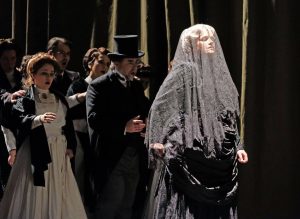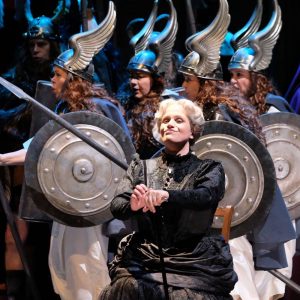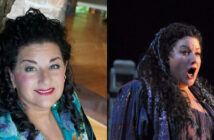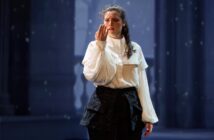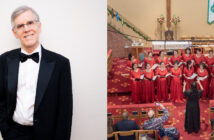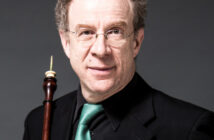PROFILE AND INTERVIEW: An advance discussion with Avner Dorman about his new opera: Wahnfried
“When I started working on this project,” recalls Avner Dorman, “there were people who said it could be controversial.”
Those people were probably right, but it doesn’t faze Dorman in the least.
“From my point of view,” the celebrated American-Israeli composer replies, “I think that’s a good thing for an opera.”
Dorman, best known to date for his “intricate craftsmanship and rigorous technique” in a dazzling array of orchestral, chamber, dance and vocal works, is about to have his first opera, Wahnfried, premiered at the Badisches Saatstheater in Karlsruhe, Germany on Saturday, January 28, 2017.
It’s a work no one is likely to accuse of playing it safe or pulling punches.
Central to the narrative is the incredible but true story of an unlikely anti-hero – a failed scientist and aesthete of British birth (and otherwise jumbled cultural bona fides) named Houston Stewart Chamberlain who, after the death of Germany’s monumental opera composer, Richard Wagner, managed to insinuate himself into the Wagner family circle, ingratiate himself with the composer’s widow, Cosima, and eventually even marry Wagner’s daughter, Eva.

Christina Niessen (Cosima Wagner), Matthias Wohlbrecht (Houston Stewart Chamberlain), Photo: Falk von Traubenberg
A wry little historical anecdote? Hardly.
In an operatic telling that Dorman himself describes as both “fantastical” and “historical,” the opera dramatizes the portentous consequentiality of this obscure-sounding family romance. For, in cahoots with Wagner’s widow, Chamberlain is depicted as effectively hijacking the very heart and soul of the Wagner mythos, radically reorienting its popular perceptions and ideological alignments – and helping trigger Europe’s real-life 20th-century Götterdämmerung, to boot.
Oh, and, by the way – all of its high stakes and big issues notwithstanding – the opera is also, at least in part, a comedy.
Open House
The opera’s title comes from the name of the elegant and austere neoclassic villa that Wagner built for himself and his family at Bayreuth. A coinage of the composer’s own, Wahnfried translates into English as something like “freedom from madness.” How deliciously ironic, then, is its application to the madcap battle royal waged largely within the villa’s walls, among a clan of Wagnerian-sized personalities, all aiming at no less a prize than control of the Ring Cycle composer’s legend and legacy.
Meet the In-Laws
Houston Chamberlain (no relation to Neville, by the way; that’s often asked; you’ll see why) appears to have been a sad and floundering social misfit through much of his youth. A cultural chameleon – if not downright turncoat – he early on renounced his Britishness in favor of a life in France, where he fecklessly pursued a series of failed careers in journalism, arts, and science.
However, upon discovering – and falling under the spell of – the music of Richard Wagner, Chamberlain abandoned French culture at whiplash speed, embraced a full-throated allegiance to all things German, moved to his new fatherland, and married his first German bride (not Eva).
That marriage eventually faltered, but it is at a juncture just before Wagner’s death that Wahnfried takes up Chamberlain’s tale.
Flattering his way into Cosima Wagner’s esteem, Chamberlain found himself accepted as a sort of surrogate son, thereby finally achieving a sense of belonging and legitimacy that had long eluded him. It was a sea-change so exhilarating to him it apparently enflamed a previously dormant, and noxious, strain of literary genius.
In 1899, Chamberlain published an inflammatory pseudo-anthropological treatise called The Foundations of the 19th Century which codified the miasma of ugly, half-baked sociological myths swirling about in the then-current zeitgeist – notions of superior versus inferior races, pure versus tainted national bloodlines, all of it laced with a toxic dose of anti-Semitism and Teutonic supremacy polemics.
Making Friends, Influencing Kaisers
The book was a hit, and granted the Wagnerian arriviste his newfound share of fame and credibility. Along with fans such as Kaiser Wilhelm, The Foundations also inspired a restless younger generation of agitators and activists, including one militant young house painter with political aspirations. Indeed, Chamberlain’s book proved a major success for the same publisher who would later make a killing – so to speak – with another lucrative blockbuster entitled Mein Kampf, the author of which (the aforementioned house painter) counted Chamberlain as an inspiration, and cultivated him as a friend.
In short, as depicted in Wahnfried, it is Chamberlain – aided and abetted by Cosima – who largely grafted the taint of anti-Semitism and fascist-friendliness onto Wagnerism, while also inestimably enriching the incipient Nazi enterprise by extending the glamor and authority of Bayreuth to the man Chamberlain dubbed a “new Parsifal,” Adolf Hitler (portrayed in Wahnfried as “Der Meisterjünger”).
A Breath of Scandal
So what about those controversies that Wahnfried is likely to engender?
Well, one prospective source of pushback, according to Dorman, could be those who feel Wagner himself is too easily exonerated in the opera. After all, it’s not hard to cull blandly anti-Semitic remarks (commonplaces, actually, for their time) from Wagner’s surviving letters and journal writing; but it’s less patently obvious that any proto-Nazi ideas are actually manifest in his work.
In fact, it’s to the contrary, according to Dorman, who has a novel and paradoxical view of the “superman” element commonly presumed to pervade the Wagner canon.
“His characters are so weak and tragic,” remarks Dorman. “They don’t fit – in my opinion – the Nazi ethos very well at all!” Rather, all that Master Race discourse alleged to be so Wagnerian – and all so useful to Hitler and his crew – was, according to Dorman and his collaborators, the sinister handiwork of Cosima and Chamberlain.
A Word from Valhalla
“Wagner himself doesn’t sing in the opera,” explains Dorman. (Indeed, the opera places the composer’s death close to its outset.) “But his spirit – the ‘Wagner Demon’ – does appear.”
And that demon becomes a major figure in the opera’s second act. While it remains ambiguous whether it’s Wagner’s actual ghost, or merely a projection of Chamberlain’s belatedly guilt-wracked psyche, this figure nonetheless is “against Chamberlain in many ways,” explains Dorman.
“He tells Chamberlain ‘You don’t get me’ and ‘You’re an opportunist.’”
Moreover, reinforcing a case against imputing virulent racism to Wagner, the specter of the composer’s great colleague and admirer, the Jewish conductor Hermann Levi, also appears in Chamberlain’s fevered dreams.
“If anything,” says Dorman of the opera’s inherent argument, “it shows – and this is on strong historical basis – that Cosima and Chamberlain reinterpreted Wagner.”
But the elements in Wahnfried ripe for robust debate don’t stop there.
“We didn’t take a cautious approach in the writing,” declares Dorman. Of Wagner’s son, Siegfried, for instance, “there’s the element of whether he was gay” (not to mention whether the family attempted to avert revelations about said gayness). Of course, the explosiveness of such a taboo has to be viewed in historical context – an analogous bombshell from the same era, known as the “Eulenburg Affair,” involving the outing of one of the Kaiser’s closest friends, came close to toppling the German monarchy.
Oh, and Wahnfried also treats of Siegfried’s face-saving marriage (at Cosima’s behest) to a much younger, British-born wife, Winifred, about whom rumors persist that she “ended up being Hitler’s lover,” according to Dorman.
In short, the monkeyshines at chez Wagner appear to have been a fit match for anything the Master cooked up for his lurid Brabantian court in Lohengrin.
So be it. For Dorman, it’s all “added value.”
“Spending this much time and effort on a single piece,” Dorman remarks, “the more it says, the better my time was used.”
A Few Laughs
Some of Wahnfried’s humor stems from Dorman’s witty and irreverent treatment of musical quotations from Wagner himself.
“I hadn’t realized that it would be that kind of funny,” Dorman has blogged delightedly, for instance, about the rehearsal at which the orchestra first performed his elaborately scored gag of clashing, simultaneous excerpts from Rheingold, Tristan and Siegfried. “Everyone laughed…. Me too.”
At a much deeper level, however, the opera’s humor illuminates and supports a gradual transformation in tone – beginning in farce, moving into darker territory of psychological symbolism and magical realism, and arriving at a chilling, monitory reflection on the far-ranging and destructive effects that even mediocre minds can have if granted misplaced trust and credibility.
The Story Must Sing
When Badisches Staatstheater’s general musical director, Justin Brown (who, in his previous post as music director of the Alabama Symphony Orchestra, had already commissioned and premiered works by Dorman), proposed that Dorman try his hand at opera, the two of them, along with Badisches Staatstheater artistic director Peter Spuhler, sat down to brainstorm ideas. Many arose, many were discarded.
“It has to make sense that it should be an opera,” Dorman reflects. “Some stories justify the medium in a very strong way.”
Finally, Spuhler – who happens to be distantly related, by several generations’ remove, to Chamberlain’s first wife – mentioned the Chamberlain/Wagner story. That was it. The tale proved, according to Dorman, to be one of those that “wants to be an opera, and not necessarily anything else. It asserted itself, and really captured everyone’s imagination.”
Husband-and-wife playwriting team Lutz Hübner and Sarah Nemitz were brought onboard as librettists. Visionary director Keith Warner was engaged. The research was rich and exciting.
“Now we had to write it,” says Dorman.
The Beat Goes On
“I started out with rhythm, and the flow of the language,” says Dorman. “I can hear the music in my head, but instead of writing it all out, I just wrote the basic contour. One of my goals was to keep the dramatic tension alive the whole time.”
It’s not an approach Dorman had previously employed for his instrumental or choral or dance works, and its instinctive theater orientation is striking for a composer broaching the opera form for the first time.
“People have remarked that it’s very theatrical,” confirms Dorman, “which I take as a great compliment. Maybe because I haven’t done this before, I had to devise some system that would keep me in the flow. I think it’s easy to get lost in what you’re good at.”
All in the Timing
Wahnfried is a big work, with twelve singing roles, plus a double chorus of another 45 singers, and an orchestra of around 65. Indeed, in Dorman’s expansion of the classical operatic orchestra for Wahnfried, one finds several extra percussion players, including a pianist who also spends time at an electronic keyboard and, at one point, a toy piano.
“I personally feel that rhythm and time are the main dimension in which music happens,” says Dorman. “The only way we can conceptualize time, really, is through sound or rhythm. The clock is a metronome. Time and music are very closely aligned.”
So, what is the musical language of Wahnfried?
“The opera is in the vein of The Nose by Shostakovich, and Ligeti’s Grand Macabre, and some of the late pieces by Mauricio Kagel,” Dorman explains. “The pitch material is not tonal or neo-tonal in any way. Rhythmically, it’s very active. There is actually a lot of march music in the background. I wanted to get the feeling that all of this actually leads to two giant wars.”
And it’s the fatal beat, that looming doom – the dark reality that a putatively “civilized” world not once but twice tore itself asunder in the course of one half-century – that ticks and rips away at all the comic zest and farcical energy of the opera until its heart lies disclosed.
“There’s a big advantage for opera to address bigger issues about these painful corners of history, and of what humans do,” says Dorman. “Opera has the advantage of the music, and it can actually say these things in a non-prescriptive, non-moralistic way. You get it as an audience – it doesn’t have to be hammered in the text itself.” (A felicitous – and eerie – echo of Wagner, perhaps, who wrote that music “is able to express in tones that which one is unable to say in words.”)
“I can see that some people might be offended by some things in the piece,” Dorman continues, “but the goal of telling this story is to show us all what we are capable of, and what certain kinds of thoughts and ideas lead to – more than ‘you were wrong here.’”
“Perhaps the most important thing,” Dorman says, “is that, in the end, these tendencies in humanity are not gone. Racism has not been eradicated. It’s not like it happened this one time in history and never did anyone ever say anything like this again. I think it’s quite timely.”
Still, says Dorman, “I understand that for many people – for people in Israel, for instance – even for me – it’s difficult to see Hitler on stage like this.”
He then adds with a wry laugh, “Even though I wrote it.”
Wahnfried will be presented January 28, February 2 and 16, March 19, April 12 and 24, and May 12 at the Badisches Saatstheater in Karlsruhe, Germany, in a season that will also feature the theater’s new production of the Ring Cycle, as well as an installation honoring the memory of the great Jewish conductor, and Wagner enthusiast, Hermann Levi; additional information on Wahnfried is available here.



